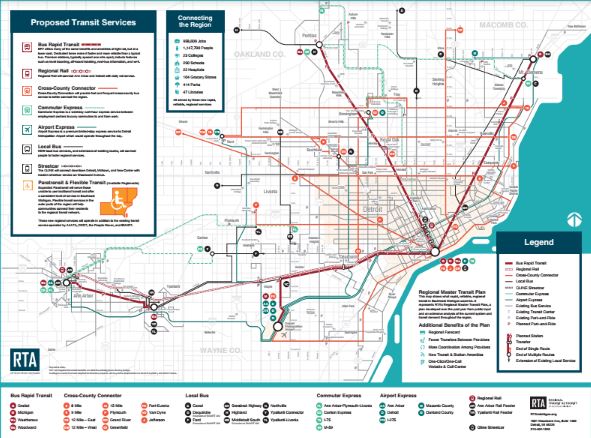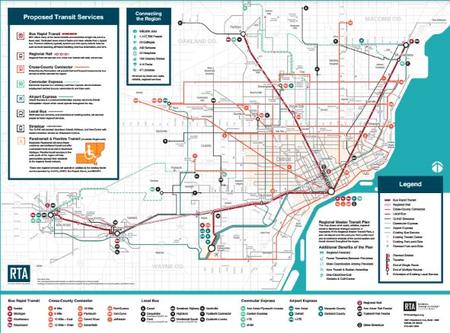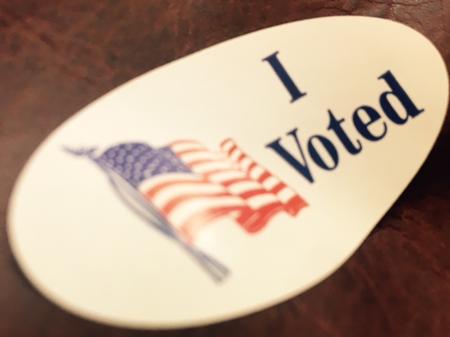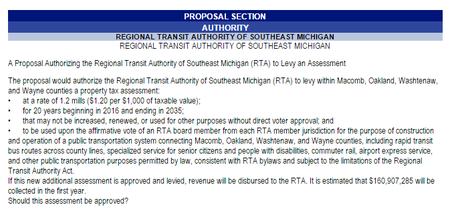Detroit Transit Advocate on the RTA Millage Proposal
Transit Activist: Having ballot question about RTA means voters decide future of mass transit in the region.

“One of the great things about ballot measures is that the voters have the direct decision. You aren’t asking someone else to make it for you. You have the chance to decide, is this transit improvement worth investing in?” — Megan Owens, executive director of Transportation Riders United
Hundreds of miles of routes. Dozens of new stops. Connections across counties and existing system borders. Express service to Detroit Metro Airport.
And more property taxes, with sometimes the highest payments from people who may be least served by the new transit system.
That’s some of what’s at stake with Tuesday’s vote on a 20-year, 2.1-mill proposal to fund a southeast Michigan Regional Transit Authority master plan in Macomb, Oakland, Washtenaw and Wayne Counties.
The total vote count over the four counties will determine the outcome. There’s no opting in or opting out.
For Megan Owens, executive director of Transportation Riders United, it’s a watershed moment. The long-time transit advocate talked with WDET’s Sandra Svoboda about the proposal and how she would have designed the plan.
Here’s a transcript of their conversation:
Sandra Svoboda: As we’re looking at having this vote in November, where does this fall as an event in Detroit transit history?
Megan Owens: This is an extraordinary opportunity for this region to finally make a leap forward in providing people the reliable regional transit connections that we’ve been lacking for so long. This entire four-county region – not only Wayne but Oakland, Macomb and Washtenaw Counties – are all going to have an opportunity to vote on November 8th. That’s never happened. We’ve never had the entire region come together to vote on something like regional transit so it’s a huge step forward.
SS: Why is it up to voters to make this happen for the funding?

MO: So the Legislature that created the Regional Transit Authority back in 2012 gave the Regional Transit Authority certain powers to do things directly themselves. They have a board, they developed the plan, they can implement transit but before they can actually tax the voters it is up to voters to decide, so the voters have an opportunity to say is this in fact an investment we want to make? And if so then the RTA will then implement the funds that they allocate.
SS: At Transportation Riders United you’ve advocated for transit for a long time. Is this the plan you wanted?
MO: This is a huge step in the right direction. To be honest, if I had mapped out the plan myself I might have done a few things a little differently. But I also would have given myself a much larger budget. The reality is this plan does an excellent plan of providing both some exciting new services like a regional rail between Detroit and Ann Arbor, rapid transit on major corridors, airport express service, while also addressing some of the huge gaps we have in people being able to get to jobs and senior being able to stay independent while also staying within a reasonable budget cost so I think while it may not be exactly how I may have mapped it out, it’s an excellent plan for what this region needs.
SS: When the plan was designed what was the thinking into the funding level that’s there? Why couldn’t some services be sacrificed to have a lower millage rate for residents?
MO: Well it was really a political compromise. The leaders of Wayne, Oakland, Macomb and Washtenaw counties and the city of Detroit and numerous other leaders in the region were involved in deciding what is a reasonable millage level to put on the ballot. The RTA while it has the authority to move forward, it gives working within our regional political context and that, the 1.2-mill level that is on the ballot was something that the RTA felt they could develop a robust plan to really help the region and the county leaders felt was reasonable to ask voters if they were willing to provide.
SS: For the people that oppose this because they don’t live in an area that’s directly serviced at this time, what’s your argument to them to vote for it.
Source: State Tax Commission
MO: This will not only expand service into a lot of new areas. So there are places that don’t have any bus service right now that will once this plan is in place and implemented. Rochester, Novi, Wixom, Plymouth, Canton as well as the connections between Detroit and Ann Arbor, but that’s true. There are some areas way in the north of the northern or southern outer edges of the metro region that won’t have direct, fixed route buses but they will have paratransit service for seniors that will be connections for how seniors and people with disabilities can connect from those outer communities into the core of the region as well as there’ll be things like park-and-ride services so you only have to drive part of the way and then not have to deal, be able to take transit down for like a ball game or other events and not have to deal with the hassle and cost of parking but then honestly even if people never ride the transit, having a regional transit system is great both for employers to have reliable employees, that’s one of the reasons we’ve got huge support from the business sector all across the region, it’s also great if you want your kids and grandkids to live in this region, if you want to be able to visit them without having to get on an airplane, we better have the type of transit that young professionals, millennials, that young people want to have and that includes transit. And there’s certainly economic benefits as well: $4 return into the region for every dollar invested, so even if you never ride there are some excellent reasons why transit will be a benefit for you and for our whole region.
SS: Southeast Michigan is a community that doesn’t really have a tradition of mass transit, it doesn’t have the culture of riding subways and trains like other cities. The money is one thing to put the services in place, but what are the plans to kind of change how we embrace the idea of riding?

MO: It’s about giving people choices. We’re not dragging anybody from their car. The idea is to give people options of how they want to get around. Some people will chose to use it and find it a convenient way to get around. Other people will choose not to ride but maybe there’ll be less traffic on their commute so there’s a benefit right there. But the reality is transit is essential for everyone in this region, whether you personally ride it or not.
SS: What critiques do you have of the plan?
MO: As I said, I would certainly love for it to be even more or to be done even faster but I understand both the political realities, the technical realities and yes, it takes a while to build these things. I think all in all they’ve done a good job of balancing the needs to provide service across the entire region. Every county, there’s a requirement in there that every county the dollars raised, a minimum of 85 percent of the dollars raised in that county will be spent on services in that county so there’ direct return on investment but then there’s also a need to provide where do people need to go across the entire region. Our lives don’t end at our city or county boundaries so it’s a good balance of providing services where people need them and ensuring everyone gets some direct benefits.
SS: We’ve heard concerns from some taxpayers that the plan is asking for too much. How comfortable are you with the numbers and that the funding levels are correct for the services that are most needed and planned for?
MO: There was certainly a lot of financial analysis that went in to make sure that the numbers were legitimate and that the RTA can in fact implement the services with the dollars that it got. I think it’s important to recognize that our region here in southeast Michigan has the very lowest per capita spending on transit of any metro area in the entire country. We’re spending a third to a quarter of what most major metro areas spend and you get what you pay for. You can see so even after this is implemented, we’ll still be, we’ll go from about least in the nation to about third least so it really is, when you look at transit systems across the country, a very modest reasonable investment, and when you look at all the benefit it’s going to provide, I believe people will see it’s an appropriate investment.
SS: Talk a little bit about how the dollars raised will be spent in that community, that guarantee or how that formula will work.

MO: So the RTA did very carefully analyze how much is currently being raised by property taxes in each county, how much is likely to be raised over the next 20 years with some pretty conservative estimates, and adjusted the plan to make sure that a minimum of 85 percent of the dollars raised are returned in immediate, direct services. So I happen to live in Oakland County and when I ride the bus down to my office in downtown Detroit, my route is about three miles in Oakland County and about eight miles in Wayne County but my tax dollars as an Oakland County resident are going to the Oakland County services. It is hard to lay out in a way, it is a very difficult for the RTA to provide that but they were very conservative in making sure the dollar raised are spent in that community. The other nice thing about this plan is in addition to the immediate dollars raised by the property tax, it will also allow the RTA to leverage state and federal dollars that we’re not reeving now. Another $2 billion that’s expected to come in over the next 20 years so not only will every county get that, a guarantee of minimum of the 85 percent of return on the investment of their dollars, every county is going to get well over 100 percent once you count in that leverage. Given a lot of the routes do go into Detroit, Detroit is getting a larger portion because so much of the region does cut through Detroit, but every county gets well more than they put in in tax dollars to make that service happen.
SS: What else can you say about the balance between the political dimensions of this plan and what the riders really need?
MO: This plan provides benefits in a couple of ways. One is that I think it really will provide some exciting new services that people who may ride transit in a lot of other cities but don’t really ride transit here might consider using, utilizing for the first time Things like an airport express service that would take people from downtown Detroit or from Macomb or Wayne or Oakland county straight to the airport on a luxury bus, coach bus with wifi and all of those benefits. So really convenient affordable airport express is hugely popular. Finally having a connection between Ann Arbor and Ypsilanti with Dearborn and Detroit, to finally connect Wayne and Washtenaw counties together and to do it with a convenient regional commuter train service running eight or 10 times a day on existing tracks would be a huge benefit. I know at least for me as someone who has family in Ann Arbor it would be great to have that connection let alone all of the different students and employees and other tourism. But it also does in addition to these exciting news services, the plan also does a lot for current riders who are struggling because of the gaps in our system. It will expand transit into new areas, major job centers like Livonia, Canton, Wixom, Novi, Rochester, that right now if you don’t have a car, don’t even bother applying for a job because you have no way to get there. If folks remember the Walking Man from last year, walking 21 miles just to get to work, this plan will dramatically cut back and make it so he could actually have a reasonable trip to work. It will also help deal with some of the having to transfer at the border. I hear stories all the time about people being stuck at the city borders for sometimes hours at a time. It’s absurd. Our lives don’t end at our city boundaries, and our transit shouldn’t either, and this plan will make it so you can travel seamlessly between Detroit and the suburbs and back again any time of the day or night, not just for a couple hours during rush hour but on the weekend, in the evenings, having that seamless connection I think will be a huge benefit for existing riders. So it provides both exciting new services and some of the improvements in seamless connections that the existing riders need.

SS: Voters are going to the polls this November to select a new president and to vote on a regional transit plan for the metro region here. How do you measure those in terms of importance to this community?
MO: Wow, that’s a tough one. I will say sometimes people feel frustrated when voting on representatives or a president or city council. You’re voting for a person and trusting that they’re going to in fact implement the policies you think ought to be done. But one of the great things about ballot measures is that the voters have the direct decision. You aren’t asking someone else to make it for you. You have the chance to decide, is this transit improvement worth investing in? You and the other voters will make that decision directly and to be honest, this is something that we haven’t had a chance to vote on ever before and it could be certainly in many years if not a generation before we have another chance like this again so I would say that this regional transit ballot measure is certainly very important. I don’t think I could say more or less than president.

WDET’s Laura Herberg and Wayne State University Student Rebecca Hanna contributed to this piece.
